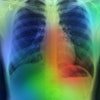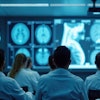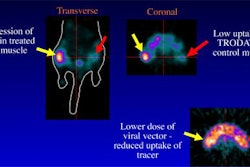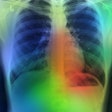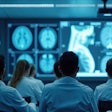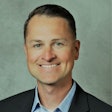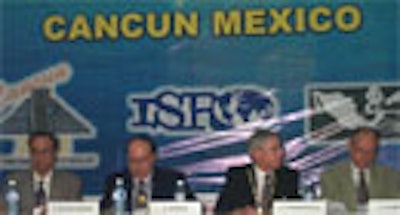
CANCÚN, MEXICO - Delegates from 71 nations wrapped up the 22nd International Congress of Radiology on Friday with a changing of the guard. International Society of Radiology president Dr. Carl Standertskjöld of Finland passed the president's medallion to Dr. George Klempfner of Australia, who will preside over the 2004 Congress in Montréal, Canada. The 2006 conference, it was announced, will be held in Cape Town, South Africa.
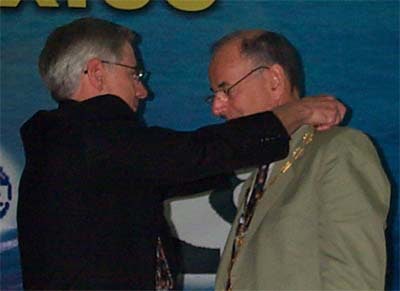 |
| Outgoing ISR president Dr. Carl Standertskjöld (left), with incoming president Dr. George Klempfner (right). |
American Roentgen Ray Society president Dr. N. Reed Dunnick from the University of Michigan in Ann Arbor gave ICR’s final address. He spoke on a topic near to the hearts and wallets of radiologists everywhere: turf protection. Education and research, he said, can help radiologists save their practices from those who would corral imaging for their own purposes.
Protection begins with radiologists doing their jobs, he said. Radiology must be accessible. Radiologists must perform accurate, high-quality work with few, if any, complications, and must produce timely reports. In addition, they must add value to medical care.
Many other medical specialists are more than happy to look at medical images, Dunnick said, but if radiologists do the research needed to maintain leadership, they will continue to add value to image interpretation.
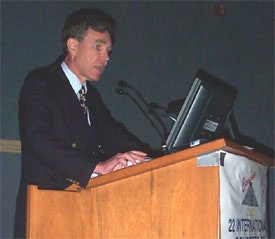 |
| Dr. N. Reed Dunnick. |
"In a way we are the victims of our own success," he said. "Radiology has become so important that we cannot take care of patients without it. Thus, many people who have not been trained want to get into the imaging business. Often, they are our clinical colleagues, who control the patients, who might even be driven by a desire for financial reward. Too often they use imaging technology not as another objective assessment of the patient, but merely to confirm a preconceived diagnosis. And usually they lack any formal training in imaging technology or in the appropriate use of that technology when another test might be more appropriate."
The opportunity to carve out parts of radiology’s workflow has been made possible by the explosion of imaging, he said. In the U.S., the population is growing by about 1% a year, and overall is growing older at a rate of about a half-percent a year. Then there is the modern practice of medicine, which plays a much more predominant role than in years past. The growth of imaging in medicine alone increases the number of imaging studies needed by about 3% a year, he said.
Together, these factors are increasing procedure volumes by about 4.5% a year, Dunnick said. "In fact, when you consider the relatively stable use of plain films, and the more dramatic increases in the use of CT, ultrasound, MR, and image-guided procedures, the RVUs (relative value units) have gone up even faster than the number of procedures," he said. As a result, the workload in radiology is increasing by about 6% a year.
Meanwhile, back on the supply side, the number of radiologists entering the field is increasing by about 4% a year, while 2% are retiring annually. The result is a net gain in radiologists of about 2% a year, only a third of the 6% increase needed just to handle the increased volume. The personnel shortage extends to radiologic technologists, radiology nurses, and radiology physician assistants.
Radiologists face enormous pressures just to keep up with the daily workload, Dunnick said, and as a result, have neglected research. "Today's research is tomorrow's practice," Dunnick said. "As our clinical colleagues look with envy upon our clinical procedures, and think about trying to do them, we need to maintain the intellectual leadership, and to do so through research."
Other specialists such as cardiologists are tapping into an increasing flow of research dollars. What's more, they are performing credible, competent research.
"Radiologists lack adequate research training. We have been working so hard to keep up with advances in our field that we have neglected the research component," he said. "We lack the time to do feasibility studies, to write and rewrite these lengthy grant applications, and we also lack the time to even conduct that research."
The solution is multifactorial, Dunnick said. Residency programs need to be enlarged, and more international graduates must be recruited. Finally, the retirement of radiologists must be slowed down, in part by creating part-time jobs that make it attractive for experienced radiologists to remain in the work force.
For this to occur, the U.S. government must first relax residency caps and make it easier for international radiologists to obtain U.S. visas. Then state licensing boards, healthcare institutions, and insurers must do their part to ease the way for foreign radiologists to practice in the U.S. Perhaps most important, radiologists need to create a "culture of research," Dunnick said.
"We can use teleradiology. Move the images, not the radiologists," he said. "This allows people to work more efficiently by sending images from smaller locations to larger concentrations, and it also allows radiologists to work at more convenient locations. We need to support subspecialization. Not only can this help us practice better radiology, but may encourage some radiologists who want to practice in only one area, such as pediatric radiology or breast imaging, to work entirely in their field of choice, rather than requiring them to cover the spectrum of radiology."
By Eric Barnes
AuntMinnie.com staff writer
July 8, 2002
Related Reading
ARRS president urges rads to take stock in the future, April 29, 2002
Copyright © 2002 AuntMinnie.com

